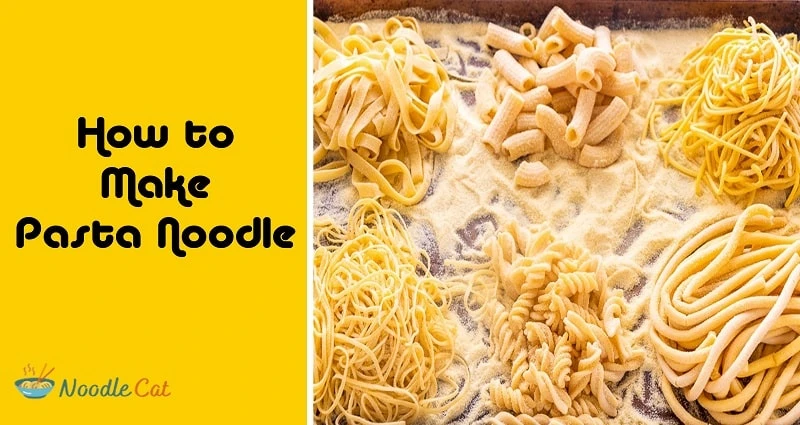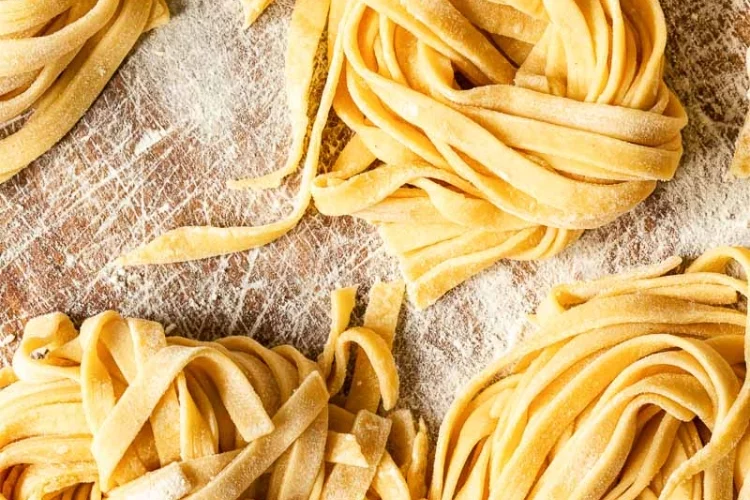by Daisy Dao
You might find it’s almost impossible to make homemade pasta without a pasta maker. But you’ll be surprised by how easy it is.
Homemade pasta, like most stable recipes that require some combination of eggs, flour, and water, is extremely simple to make by any stretch of the imagination. In fact, it is one of the simplest and most forgiving doughs you will ever work with.
On the off chance that you are a fanatic of custom made pasta noodles and you are searching for tips and deceives to manipulate and cut the mixture by hand, or utilize a kitchen stand blender to blend and a roller to level and cut then here you will gain proficiency with every one of the tips you need to make a superb pasta noodles
Contents
Let’s get started.

Pasta noodles are something that anyone can want to make at least once in their lives. Most of us, I’m sure, cook the simple dried pasta that comes in a packet. So, if you want to learn to do more, this recipe has simple steps and instructions that are also suitable for beginners. The end result is pasta that not only tastes delicious but also has the right texture.
Ingredients Needed
Water, eggs, olive oil, all-purpose flour, and semolina flour are the most basic ingredients for producing tasty pasta noodles. I’ve made pasta noodles before with just all-purpose flour and felt they were too doughy. Semolina added a nutty flavor to the pasta noodles. Furthermore, it improves the flavor and texture. Even though you can use semolina alone, it is more ideal to combine it with all-purpose flour so as to get a dough that tastes great.
1. First combine all of the ingredients you have by mixing them on a clean surface or in the bowl of your stand mixer.
2. Next you will need to knead the dough and cover your dough either with a plastic wrap or a towel, and let it stay for at least 30 minutes. This will allow the gluten to form giving your pasta noodles the chew it needs.
3. After the rest period, you will then roll it out by folding it into thirds from smoother edges and continue rolling it further to make it thinner and thinner.
4. Once the sheet is at your desired thickness, you can cut it into individual noodles.
5. Once you have rolled and cut the pasta, then you will either throw it in a pot of salted boiling water for a few minutes before you eat it, store it in an airtight container if you do not plan to eat right away, or hang your pasta on a dry rack.
1. To make sure that your pasta dough has been perfectly kneaded, stick your knuckle into the dough. If it doesn’t slowly push back, then you need to continue kneading it.
2. To know that the dough is ready, you need to check its elasticity.
3. Although you can knead the dough by hand, it is a physically demanding process. Since pasta dough is more tough unlike bread dough, kneading it can be a form of workout.
4. If you have a stand mixer, then you can easily knead the dough with the dough hook. Otherwise, you can equally knead the dough manually by hand on a well floured surface.
1. To roll out the pasta by hand, divide the dough into small chunks. You can use a dough cutter if you have one to make this step even easier.
2. Make sure you are working with enough all-purpose flour on your surface and rolling pin to prevent the dough from sticking. Roll out the tough to create long sheets that are about 1/8 inch thick
3. Once the sheets are well rolled out into long and then sheets, you can slice them into noodles using a clean straight edge like a ruler.
1. When working with small pieces of well-floured dough, you need to send them though the roller on the widest setting. Fold the dough into thirds and send it back with the folded end on the sides. Repeat the process one more time but this time with the widest setting. Why you need to do this sis to get the pasta sheets with straight edges.
2. Continue working on the dough through the rollers, rotating the dial each time to make the sheet more thinner.
3. use the thickness setting of 5 to get even more thinner pasta.
4. Once you have your pasta sheet, then you can make your own lasagna or ravioli.
5. Make sure each of the noodles are well covered in the flour so they do not stick.
1. One of the most delicious combinations is some basic meatballs and nicely cooked pasta noodles.
2. Fettuccine Afredo made with homemade pasta and a rich garlic.
3. Another option of meal to serve with pasta noodles is some meat and cheese ravioli or butternut squash ravioli.
4. You can also serve pork marsala together with pasta and it would taste incredibly delicious.

If you want to make your pasta ahead of time and prepare it for later, you can either leave it twisted down the middle after draping it to dry or twist it into little homes by delicately spinning noodles through your fingers and put in a Ziplock bag in the ice chest for later (custom made new pasta will store in the refrigerator for around 2 to 3 days).Alternatively, you should freeze them for 2 to 3 months.
On the other side, dried pasta can be obtained and stored in your washroom in the same manner as dried locally bought pasta. To dry your pasta, put it in a dehydrator at 135oF for 3 to 4 hours, or until it is dry and weak enough to snap in half without splitting.
You can also air dry hand made pasta, although it will take longer. Before storing your pasta noodles in a plastic bag or a holder in your pantry, make ensure they are fully dry and snap fifty-fifty.
Cooking dried tailor made pasta is similar to cooking dried locally acquired pasta. Refrigerated and frozen pasta can be cooked for about the same length of time as fresh pasta, maybe 30 seconds to a minute longer.However, once more, measure one noodle to ensure you’re satisfied with the doneness before worrying noodles, just in case you need to cook them for a little longer.
As it turns out, this article intends to demonstrate an easy pasta recipe and technique for making pasta by hand that is much simpler. When making pasta, the trick is to make sure the dough is pliable and smooth. By the time you’ve done kneading it, it should sound like a refrigerated silly putty. Whether it’s messy, pillowy, or breaks quickly, you’re not going to like it.
The most incredible part of this strategy is that you don’t need a machine, even though I do own one, reasonable Atlas machine. I bought a pasta machine with the intention of using it all the time after I finished culinary school, but the fact is that the machine scares me.There’s the gears, the folding, and the issue of where to dry the pasta. When you hand roll and cut your pasta, it dries during the process, so all you have to do with the pasta at the end is dust it with more semolina flour.
 |
 |
 |
 |
 |
 |
 |
 |

About Daisy Dao
Daisy grew up on the beautiful Honolulu island where she often found herself spending most of her day enjoying the ocean scent in sea waves. As such, Daisy came to appreciate the art of cooking seafood. She has experimented with baking, roasting, broiling, poaching, grilling (and every other cooking technique you can think of); and with all kinds of spices too. Now she is ready to present her experience: the art of cooking healthy food without any pre-packaged ingredients; food product recommendations for people who need a bit more guidance on what goes into their bodies; how to maintain an active lifestyle without having to give up your favorite foods!
Kitchen Goodness
Check for FREE Gifts. Or get our Free Cookbooks right now.
Disable the Ad Block to reveal all the recipes. Once done that, click on any button below
 |
 |
 |
 |